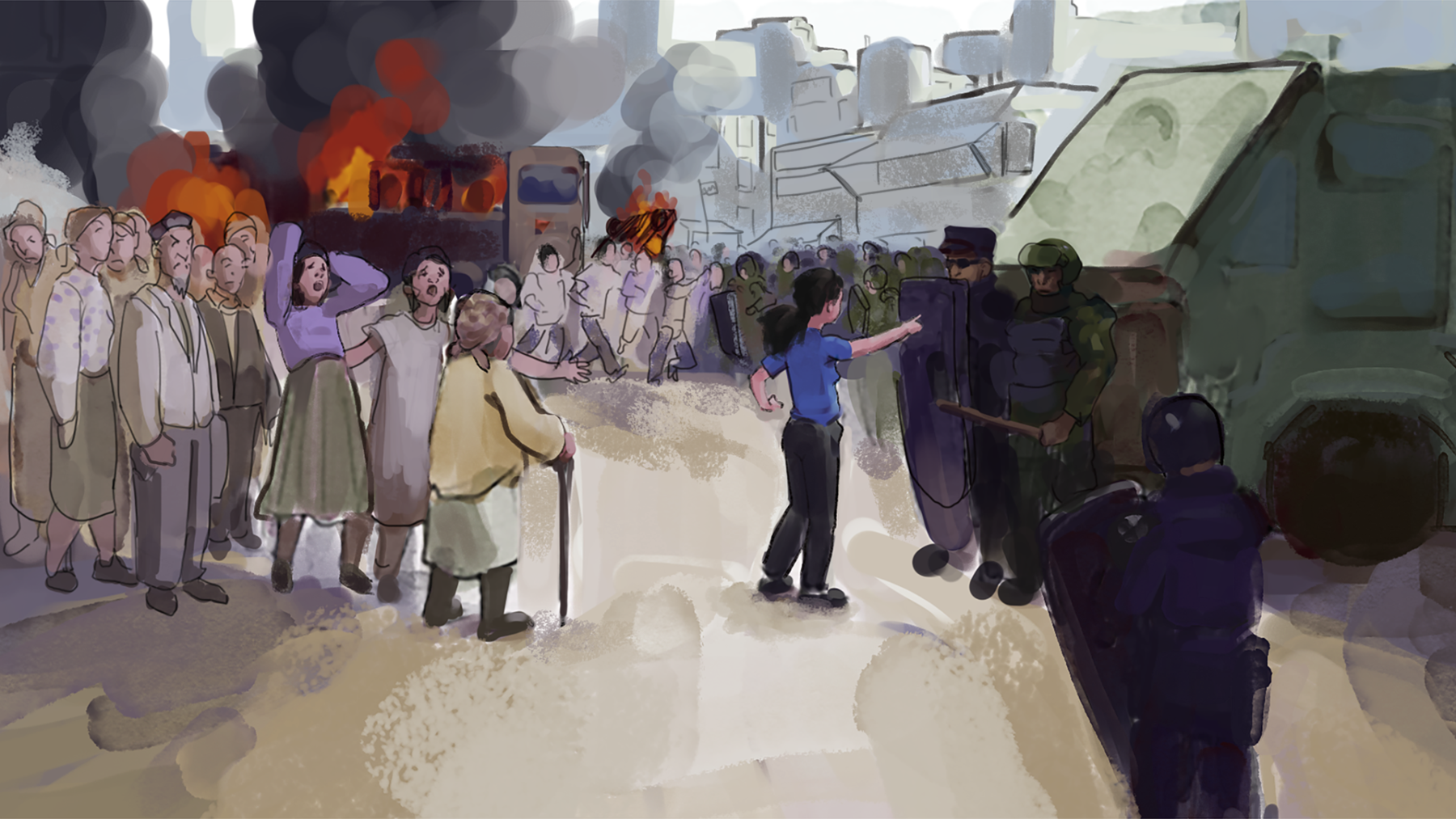
Who are the Uyghurs?
The Uyghurs are a largely Muslim Turkic ethnic group, with their own language and culture. Roughly 11 million are in China, and 1.5 million more live around the world. For centuries, Uyghurs have lived in a vast region of deserts, mountains and lakes in the far northwest of China, known today as Xinjiang. For thousands of years, leaders, tribes and China’s imperial dynasties have fought for control of this resource-rich territory. Around the 10th century, Arab influence arrived in the region and Islam became a part of Uyghur life.
During the Qing dynasty, the region was brought once again under Chinese control. In the late 19th century it was given its current name, Xinjiang, which means “new frontier” in Mandarin.
Today, Xinjiang’s Uyghurs are subject to a comprehensive, targeted campaign of surveillance and control. According to leading researchers and human rights groups, as many as 1.5 million have been placed in concentration camps. This ongoing program of repression follows decades of tension between the Uyghurs and the Chinese government. So, how did we get here?
1949: Declaration of the People’s Republic of China

As civil war raged in China in the 1940s, Xinjiang experienced a brief period of independence and became known as East Turkestan. On October 1, 1949, Chinese Communist Party leader Mao Zedong declared the creation of the People’s Republic of China and brought Xinjiang under its control.
In 1954, the People’s Republic designated the Uyghurs as one of China’s officially recognized ethnic minorities. The classification of these groups went hand-in-hand with the state’s aim of fostering “a great family founded in principle on ethnic equality” and bringing minorities together under the common vision of a communist China.
In 1955, the People’s Republic established the Xinjiang Uyghur Autonomous Region. In practice, the Uyghurs were not given any significant political power. This focus on ethnic identity and autonomy was seen as a way of quelling independence movements while maintaining Beijing’s power over China’s regions.
1966: The Cultural Revolution arrives in Xinjiang

In 1966, an ageing Mao was keen to quash his opponents once and for all. He wanted to reinvigorate the Communist revolution and purge China of any lingering remnants of capitalism and traditional life. To achieve this, he called on the Communist Red Guards to attack the “four olds” – old ideas, old culture, old habits, and old customs.
In Xinjiang, Uyghur life was upended. Mosques were destroyed or converted into Communist Party buildings. Religious texts and Uyghur-language books were deemed anti-revolutionary, and were confiscated and burned. During this period, Mao ordered millions of China’s educated, urban youth to the countryside to do hard labor on the land. Many were sent to rural Xinjiang. Mao called the program “re-education” – a phrase that would come to haunt the region more than 50 years later.
Developing Xinjiang

Xinjiang is rich in natural resources like coal and gas, and shares borders with eight countries. From 1950 on, the Chinese Communist Party wanted to develop Xinjiang’s economy and infrastructure, and shore up support for the People’s Republic of China along its outer borders. The state began to encourage Han Chinese people – China’s dominant ethnic group – to migrate to Xinjiang. They were often lured with the promise of employment, housing and a better life.
Skilled Han migrants were strategically relocated and placed in jobs to develop the region’s oil, gas and cotton industries, and frequently given priority over Uyghurs and other local minorities. Over time, inequality and segregation between Han Chinese and Uyghurs began to grow. Uyghurs earned less and had a lower standard of living than their Han counterparts, a trend which continues to this day.
Reform and opening
After Mao’s death in 1976, his successor, Deng Xiaoping, led a policy of “reform and opening” that gave Uyghurs space to explore their cultural history and revive their traditions and religion.
Read more about China’s attempt to erase the history of Islam in Xinjiang.
By the early 1990s, Xinjiang had witnessed a resurgence of Islamic devotion and ideology, and the Uyghurs had built thousands of new mosques.
Political activism also increased in the region, and protests became more common, with some protesters calling for Uyghur independence, prompting authorities to once more tighten control of the region and clamp down on religious expression. During this period, several riots erupted between Uyghurs and Chinese police and open resistance to the Communist Party became more common.
Demonstrations, civil unrest, bombings and other attacks increased during the 90s, with violence reported on both sides. Amnesty International described the 1997 protests in the city of Gulja, as a peaceful demonstration turned massacre, quoting the exiled Uyghur activist Rebiya Kadeer. “I have never seen such viciousness in my life.” “Chinese soldiers were bludgeoning the demonstrators.” The Chinese government ascribed any violence in Xinjiang during that time to “inhuman, antisocial and barbaric acts,” and made it clear that the state saw Uyghur separatism and Islamic ideology as at the root of the unrest.
In the immediate aftermath of 9/11, China began a renewed crackdown on the Uyghurs, warning its people that Uyghur separatism and religious extremism posed a terrorist threat.
2009: Riots in Urumqi

In late June 2009, a fight broke out between Uyghur and Han workers at a toy factory in the city of Shaoguan in Guangdong Province, southeast China. Two Uyghurs were killed and 120 people, mostly Uyghurs, were injured. The news was met with shock by Uyghurs thousands of miles away in Xinjiang. On July 5, a group of Uyghur students took to the streets of Urumqi, the region’s capital, to protest.
Clashes between the protesters, police and Urumqi’s Han residents quickly escalated. Protesters threw rocks and burned cars; troops and paramilitary police responded with bullets. Around 200 people were killed – according to the authorities, most were Han. In the following days, armed mobs of Han vigilantes ran through the city, seeking revenge on the Uyghurs. During the protests, the authorities cut off the internet in Urumqi. It was one of the first times in history that a government implemented this measure, now a favored tactic of authoritarian regimes across the world.
2012: The ascent of Xi Jinping

The 2009 riots marked a turning point for government policy in Xinjiang. In 2012, Xi Jinping was named leader of the Chinese Communist Party. During the first 18 months of his presidency, several high-profile outrages – including a suicide car attack in Tiananmen Square, a train station stabbing in southern China and the bombing of a market in Urumqi – were attributed to Uyghur militants. Xi made his first and only trip to Xinjiang in 2014. On the last day of his visit, two Uyghur militants attacked passengers at a station in Urumqi with knives and explosives. Three people were killed in the suicide attack, including the two assailants, and dozens injured. Xi launched what he referred to as a “People’s War on Terror” in 2014. For ordinary Uyghurs in Xinjiang, life began to change dramatically.
Watch our video about life as a Uyghur police officer in Xinjiang.
By 2015, the state began to roll out a massive surveillance network across the region, placing extensive restrictions on freedom of expression and religion in the name of counter-terrorism. Police checkpoints were introduced everywhere and Xinjiang residents were required to submit biometric information including iris scans, blood samples, DNA and voice samples and facial scans to the authorities. Millions of cameras and state-of-the-art facial recognition technology were deployed to track residents’ every move.
Xinjiang became a testing ground for the latest developments in surveillance technology. It was also given a new regional boss: Chen Quanguo, whose previous job had been to enforce a security crackdown in Tibet. Shortly after his appointment in August 2016, Chen issued an order to “round up everyone who should be rounded up.”
2017 – 2020: Camps

As the crackdown intensified in Xinjiang, authorities arrested Uyghurs for any behaviour deemed potentially “extremist” – making trips or phone calls abroad, wearing a hijab, growing a long beard, or keeping Islamic books in the house. When the authorities began to confiscate passports for “safekeeping” in some parts of Xinjiang, it became nearly impossible for many Uyghurs to leave China. Police stations sprang up every few hundred yards in Xinjiang’s cities.
Coda spoke to dozens of Uyghurs about life under Xinjiang’s lockdown. Meet some of the women who escaped.
Most troublesome of all, vast, mysterious facilities were built in the region’s deserts. Human rights organizations, journalists and activists raised the alarm: they appeared to be camps. Hundreds of thousands of Uyghurs began to disappear into them. Initially, the Chinese authorities denied the existence of the camps. In August 2018, a report put together by the UN estimated that a million Uyghurs and other Muslims in Xinjiang had been imprisoned within them.
After the UN report, the Communist Party referred to the camps as “vocational training centers” intended to “re-educate” Xinjiang’s Muslim population. That word brought back grim memories of the Cultural Revolution. The camps are guarded with great secrecy, though the state has allowed propaganda images to circulate of Uyghurs in classrooms, being cleansed of their religious ideology, taking lessons in communist history and Mandarin.
Watch our video about life in Xinjiang’s detention centers.
Uyghurs were also held in prisons and detention centers, for crimes such as having WhatsApp (a banned app in China) on their phone or messaging people abroad. Uyghurs who have been released from these centers described cramped, inhumane conditions and constant surveillance. In the fall of 2019, drone footage emerged of hundreds of blindfolded and shackled men, being marched off a train in Xinjiang. All had their heads shaved; all appeared to be Uyghur or other minority prisoners.
2020: Rebranding Xinjiang

Today, Xinjiang is promoted heavily by the Chinese state as a tourist destination. Images coming out of the region are tightly controlled, and video footage often shows Uyghurs happily dancing for visitors. Last summer, the Chinese government claimed “most people” had been released from Xinjiang’s camps and returned to society. However, according to human rights groups, as many as 1.5 million Uyghurs remain in detention, while arrests, detentions and prison sentences have surged in Xinjiang.
To understand more about how Uyghurs are using social media to track events in Xinjiang, read our story here
Uyghurs outside China who have spoken to Coda Story say they are still waiting for their relatives to be released from the camps. A leaked cache of documents published in November 2019 showed how the camps – which China maintains are for education and training – are run like high-security prisons. In March 2020, a report was published that showed Uyghurs were being transferred to factories used by global brands, including Nike and Apple, and made to work “under conditions that strongly suggest forced labor.”
Illustrations for this article were done by “Lutpulla,” a Uyghur artist who wished to remain anonymous. The map is by Sofiya Voznaya.

Isobel Cockerell is a reporter and filmmaker with Coda Story. A graduate of Columbia Journalism School, she has also reported for WIRED, USA Today, Rappler, The Daily Beast, the Huffington Post and others.
Get in touch via isobel@codastory.com

